Summary of the day: Ukraine faces mounting pressures with artillery shortages due to delayed Western aid, potentially impacting its military resilience. In response, Ukraine’s new Commander-in-Chief, Colonel General Oleksandr Syrskyi, has set strategic goals for the armed forces, focusing on logistical efficiency and technological advancements. On the offense, Ukrainian forces successfully struck oil refineries in Krasnodar Krai with drone attacks. Additionally, Ukrainian officials accuse Russia of intensifying the use of chemical weapons, contravening the Chemical Weapons Convention. Economically, Ukraine may implement reforms to meet IMF conditions for loan repayment amidst stalled US aid. On the ground, Russian advances persist near Kreminna, Bakhmut, and Avdiivka, with training for drone operations reported in east Kherson Oblast, as Russian authorities craft an illusion of support for Putin ahead of presidential elections in occupied Ukrainian territories.
Situation On The Ground And Air
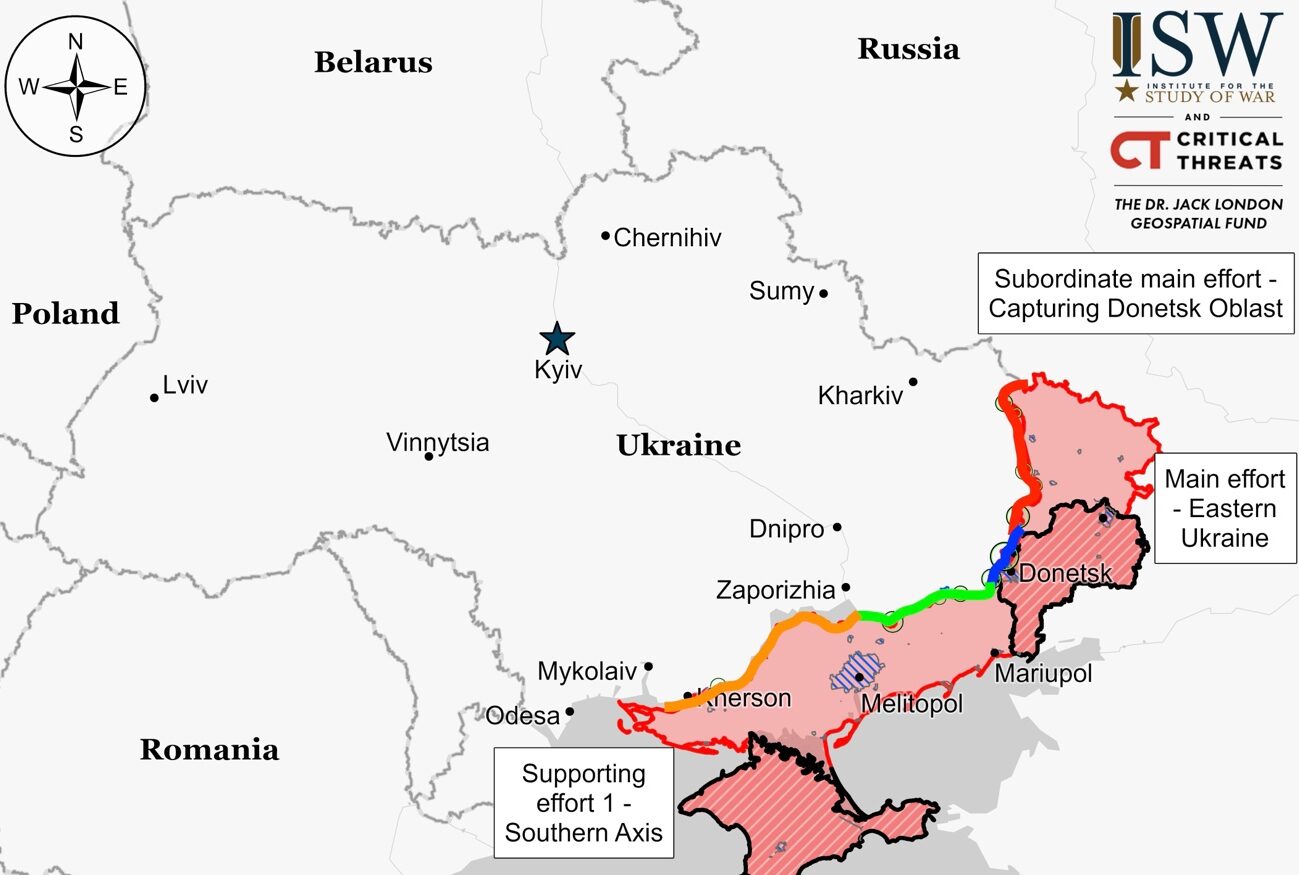
Luhansk Front – Initiative Russia
Donetsk Front – Initiative Russia
Zaporizhia Front – Initiative None
Kherson (Dnipro River) Front – Initiative None
Positional battles persisted along the Kupyansk-Svatove-Kreminna line, with Russian forces achieving minor territorial gains east of Bilohorivka, near Kreminna. Despite claims from Russian military bloggers of significant advancements, including capturing key industrial areas, there lacks visual evidence to corroborate these assertions fully. The Institute for the Study of War (ISW) has yet to verify such claims. Engagements were reported across several fronts, indicating continued tension and conflict dynamics in the region. Additionally, Russian Defense Minister Sergei Shoigu’s recent visits to command posts, including one likely along the Kupyansk or Lyman direction, suggest a strategic reassessment and a possible emphasis on offensive operations along the Kupyansk-Svatove-Kreminna line, reflecting the Russian military’s ongoing efforts to consolidate gains despite only marginal tactical successes.
Positional skirmishes persisted northeast of Bakhmut on February 9, with Russian forces reportedly seizing several positions near Vesele, though these claims lack independent confirmation. Meanwhile, limited territorial gains have been observed on both sides of the conflict around Bakhmut. Geolocated footage indicates Russian advancements west of the city and Ukrainian progress southwest, near Horlivka. Despite assertions of further Russian advancements along key highways and surrounding areas, visual evidence to substantiate these gains remains absent. The region continues to witness ongoing clashes, marking a continued tug-of-war over strategic positions in and around Bakhmut.
Russian forces made progress in northern Avdiivka and engaged in ongoing positional battles with Ukrainian forces in the region. Recent geolocated footage shows Russian advancements near a key railway bridge in northern Avdiivka. Claims of further Russian progress in residential and industrial areas of Avdiivka have been made, though independent verification remains pending. Ukrainian military spokespersons have confirmed combat in northern Avdiivka, with Russian efforts concentrated on encircling the area and targeting critical infrastructure to sever Ukrainian supply lines. The conflict has also spread to surrounding areas, indicating a continuous push by Russian forces to gain strategic advantage in and around Avdiivka.
Russian forces reportedly made advancements in Novomykhailivka, amidst ongoing battles west and southwest of Donetsk City. Claims of Russian progress reaching Tsentralna Street in eastern Novomykhailivka have been made, though without visual confirmation. The area continues to experience intense positional fighting, particularly near key settlements west and southwest of Donetsk. Additionally, recent geolocated footage highlights Ukrainian forces employing first-person view drones to target Russian tanks beyond five kilometers from the frontline, indicating the extended operational range of Ukrainian drone capabilities. This development suggests a heightened level of engagement and technological adaptation in the conflict.
Ukrainian forces successfully thwarted Russian military offensives south of Zolota Nyva and north of Pryyutne, areas flanking Velyka Novosilka, as reported by the Ukrainian General Staff. This defensive action occurs amidst ongoing operations by Russian forces in western Donetsk Oblast and along the Donetsk-Zaporizhia Oblast border, marking a continued hotbed of conflict within the region.
Positional fighting persisted in western Zaporizhia Oblast on February 9 without any significant shifts in the frontline. Battles were reported in several locations, including near Robotyne and its vicinity, highlighting the ongoing tensions in the area. Russian military bloggers have voiced concerns over the increased use of drones by Ukrainian forces, noting a deficiency in Russian counterbattery and electronic warfare capabilities. This shortfall is reportedly affecting Russian troop movements and evacuation efforts in the sector, underlining challenges faced by Russian forces in responding to Ukrainian tactics.
Russian sources reported that Ukrainian forces carried out HIMARS rocket strikes on areas behind the frontlines in the Russian-occupied Zaporizhia Oblast. According to Yevgeny Balitsky, the head of the occupation administration in Zaporizhia, the strikes targeted the settlements of Vasylivka, Tokmak, and Bohdanivka, all located along the strategic P37 Tomak-Berdyansk highway, indicating a focus on disrupting Russian logistical and supply routes in the region.
Recent geolocated footage from February 8 reveals a slight territorial gain by Ukrainian forces in Krynky, located in the east (left) bank of Kherson Oblast. This advancement comes amid ongoing positional clashes in the region. Colonel Nataliya Humenyuk, a spokesperson for the Ukrainian Southern Operational Command, noted a reduction in the intensity of Russian offensives in the area, attributing this change to considerable losses in armored vehicles by Russian forces, which has led to an increased reliance on assaults without armored support.
The Novorossiya Aid Coordination Center (KCPN), a Russian paramilitary group, is actively training drone operators in the east bank of Kherson Oblast, near Krynky. This initiative aims to equip a select group of military personnel with the skills to maneuver drones under challenging conditions, notably in areas susceptible to Ukrainian electronic warfare, where GPS navigation and drone stabilization are compromised. The KCPN’s efforts are part of a broader strategy to enhance Russian operational capabilities in the region, reflecting its ties to the Russian Imperial Legion, a group that has supported Russian military actions in Donbas since 2014.
Human Cost Of The War
The Ukrainian Air Force reported a significant drone attack by Russian forces, launching 16 Shahed-136/131 drones from Crimea and Kursk Oblast. Ukrainian air defenses successfully intercepted 10 of these drones over Mykolaiv, Kherson, and Kharkiv oblasts, showcasing the ongoing aerial threat and defense measures in the conflict. However, at least five Shahed drones breached defenses to hit civilian infrastructure in Zmiiv, within Kharkiv Oblast highlighting the continued impact on civilian areas amidst the hostilities.
At least 19 Ukrainian civilians were killed, and another 19 injured from Russian attacks over the last 24 hours.
- A devastating Russian drone strike on a gas station in Kharkiv resulted in a massive fire that claimed at least 13 lives, including three children, and led to the destruction of 15 homes. The attack forced the evacuation of over 50 residents and saw emergency services working tirelessly to manage the blaze and rescue trapped individuals. Kharkiv’s mayor, Ihor Terekhov, noted the fire’s extensive spread, covering an area of approximately one acre (3,700 square meters).
- A 47-year-old security guard was injured in the drone attack in the Zmiiv community.
- A Russian drone assault on Odesa resulted in injuries to a 44-year-old man.
- Beryslav in Kherson Oblast, Ukraine, was struck by a Russian air attack, leading to the injury of a 60-year-old woman and causing damage to residential homes and a critical infrastructure facility.
- Russian forces conducted a devastating aerial assault on communities in Sumy Oblast, Ukraine, killing three civilians and injuring four others. The Sumy Regional Prosecutor’s Office confirmed that seven KAB guided aerial bombs were dropped on Yunakivka, Khotin, and Mykolaiv at approximately 1:45 p.m., leading to the destruction of four homes and an agricultural firm’s workshop.
- Russian forces carried out 82 attacks across Kherson Oblast. The aggressive campaign resulted in two fatalities and one injury, alongside significant damage to residential neighborhoods, a healthcare facility, and vital infrastructure.
- Russian forces targeted Oblast, leading to civilian casualties and injuries. The attacks resulted in the deaths of two civilians in Avdiivka and Selydove, with an additional seven individuals injured in Selydove.
- Russia hit Kutsurub, Mykolaiv Oblast with drones, injuring one resident and damaging an ambulance. Russia also hit the Horokhiv community in the oblast, damaging a farm, three trucks, a bus, and warehouses.
- Russian troops launched 156 strikes against 24 settlements of Zaporizhia Oblast injuring two people.
- Nikopol in Dnipropetrovsk Oblast was subjected to seven attacks by Russian forces. The assaults resulted in damage to private residences, several gas pipelines, and power lines. Additionally, the Marhanets community within the oblast was targeted in an overnight attack. No casualties reported in these attacks.
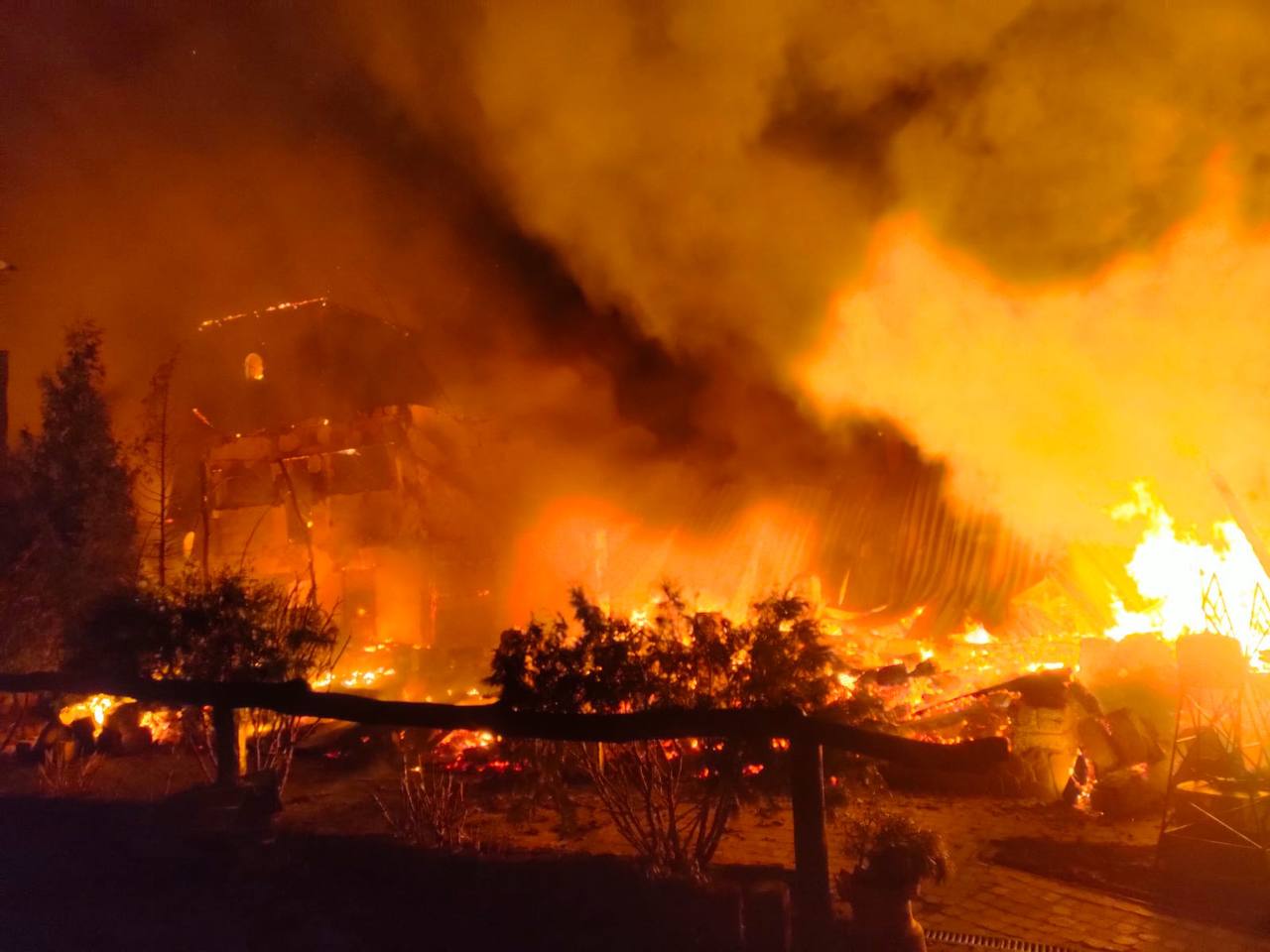 Aftermath of attack in Kharkiv
Aftermath of attack in Kharkiv
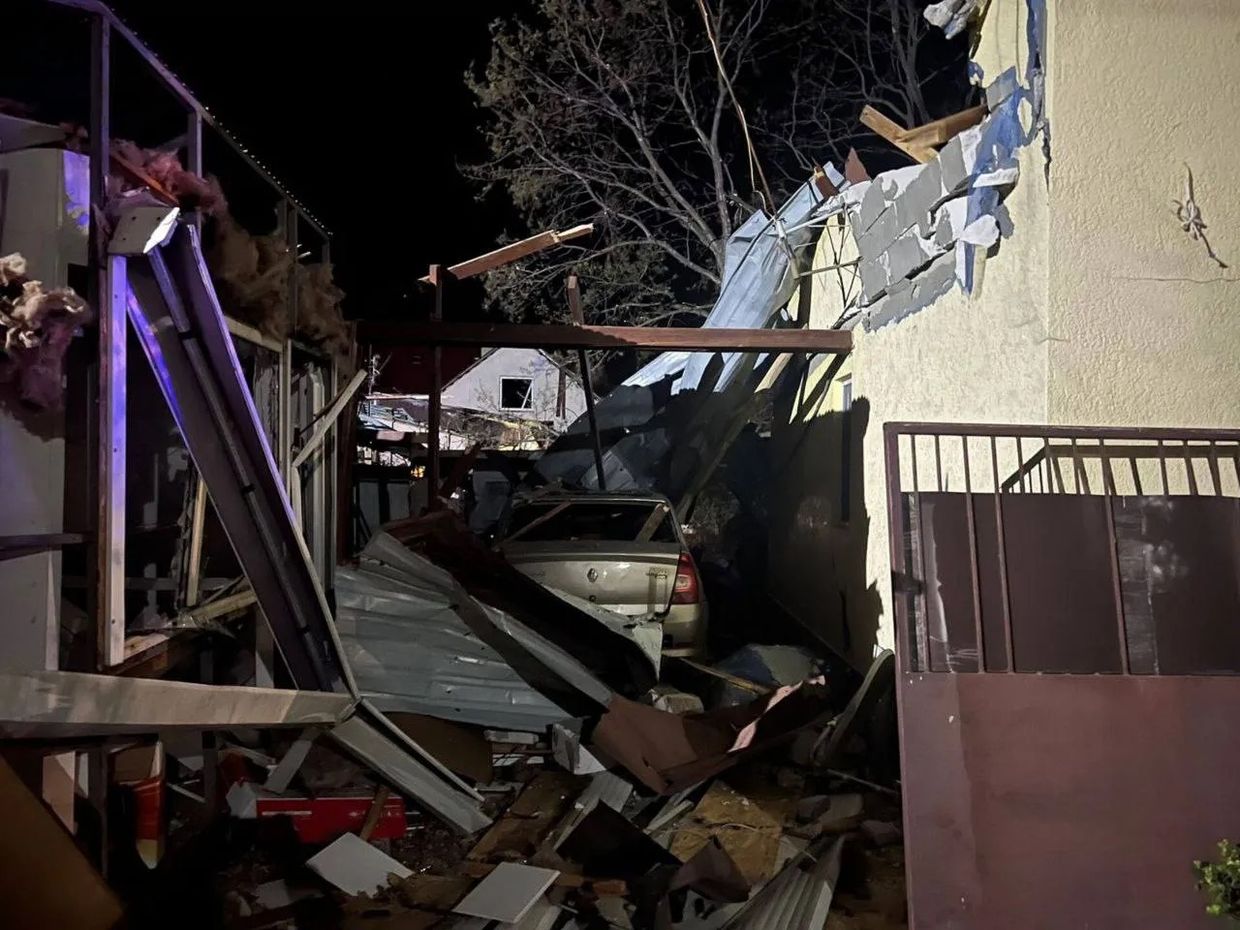 A neighborhood of summer cottages hit by drone attack in Odesa
A neighborhood of summer cottages hit by drone attack in Odesa
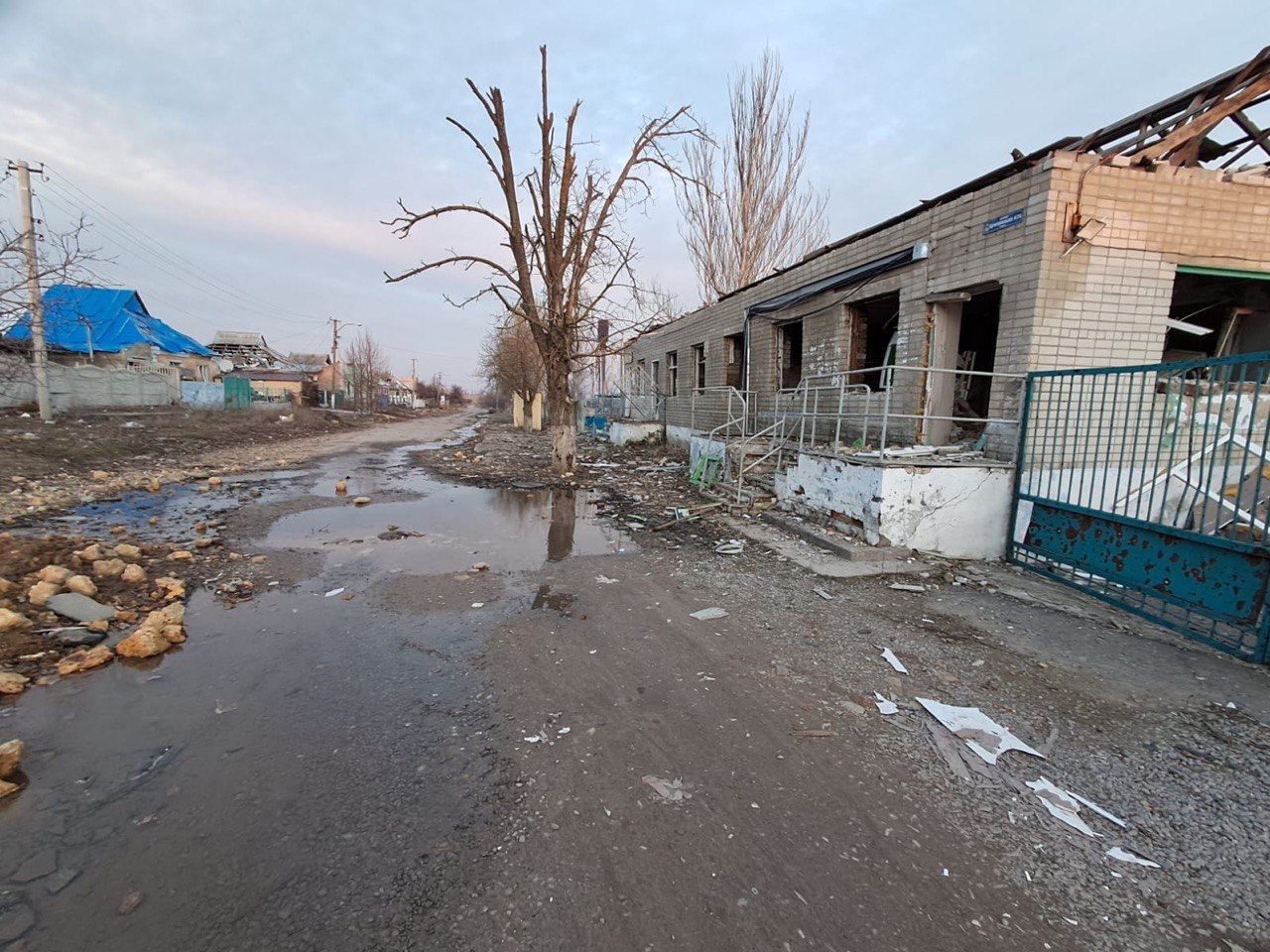 Aftermath of attack on Beryslav
Aftermath of attack on Beryslav
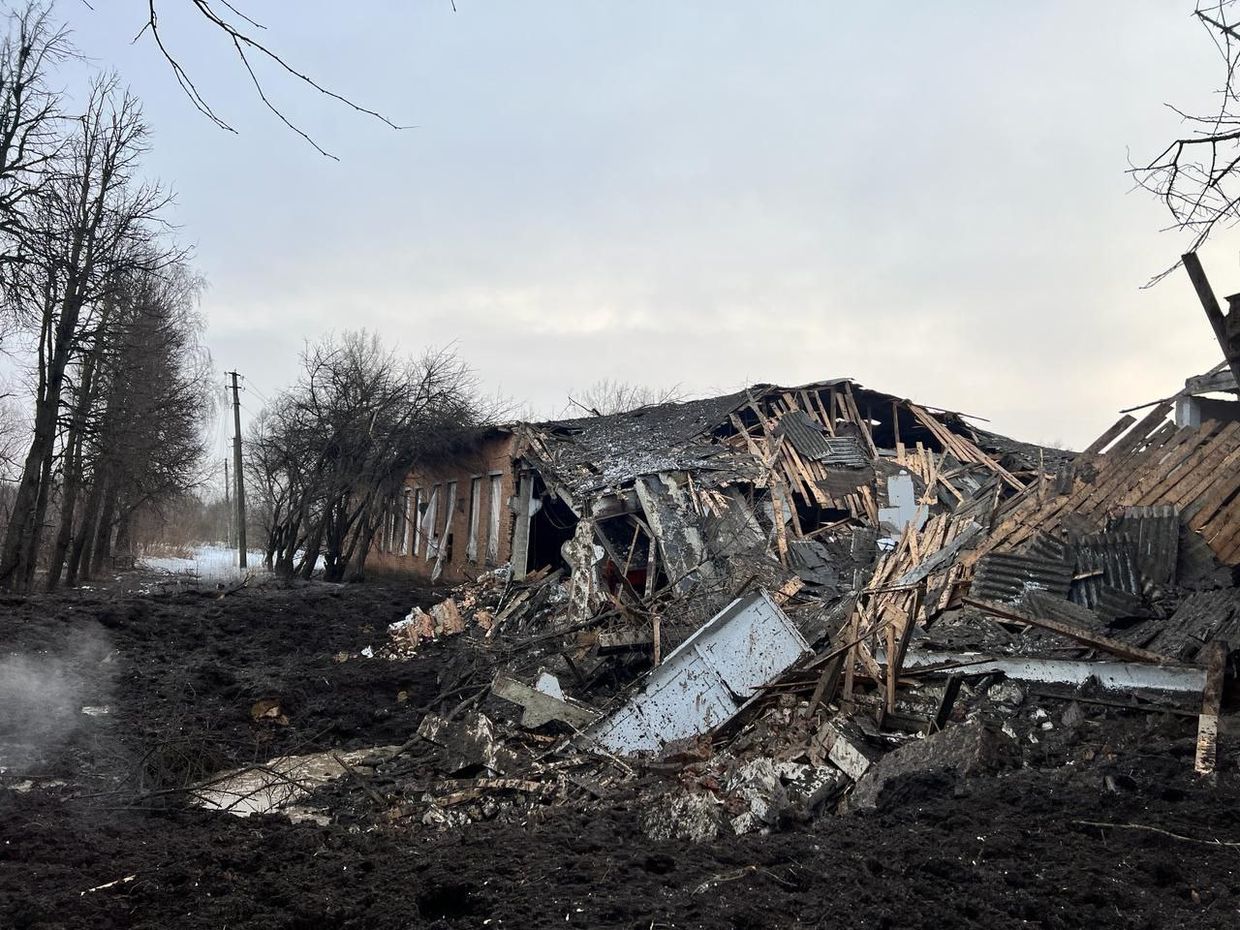 Aftermath of Russian attacks on homes in Sumy Oblast
Aftermath of Russian attacks on homes in Sumy Oblast
The General Staff of Ukraine’s Armed Forces has disclosed that Russian forces have incurred 910 casualties over the last 24 hours.
Ukraine News
Ukraine is grappling with severe artillery shortages due to delays in Western aid, risking detrimental effects on its defense capabilities against Russia. The Financial Times has disclosed that the United States’ aid is not arriving as promptly as needed, while Europe is likely to miss its own deadline to supply a significant quantity of artillery shells by March 2024. A senior US military official voiced concerns about an “air bubble” in the flow of aid, potentially leaving Ukraine in a precarious position without necessary support, including vital air defense systems and ammunition. European diplomats are similarly anxious about Ukraine’s ability to sustain its current military positions without continued Western supplies. The Institute for the Study of War has noted that a faltering in Western support could precipitate a collapse in Ukraine’s defenses, potentially allowing Russian forces to advance towards the borders of NATO countries. Moreover, there are apprehensions about Europe’s capacity to match the previously high levels of US assistance. The Ukrainian Ambassador to the US, Oksana Markarova, has highlighted a “critical shortage” in military equipment, especially missiles and interceptors, as Ukrainian forces ration air defense resources amidst ongoing Russian aerial assaults.
In a significant military leadership reshuffle, Ukrainian President Volodymyr Zelensky has appointed Major General Anatoliy Barhilevych as the new Chief of General Staff of Ukraine’s Armed Forces. Announced during his evening address on February 9, this appointment follows the recent promotion of Oleksandr Syrskyi to Commander-in-Chief, suggesting a strategic realignment nearly two years into the conflict with Russia. Barhilevych, succeeding Lieutenant General Serhii Shaptala, is hailed by Zelensky for his experience and understanding of the war’s demands. This change is part of a broader leadership overhaul aimed at infusing “fresh energy” into Ukraine’s defense strategy amidst internal leadership tensions. Additionally, Zelensky disclosed that Syrskyi has proposed candidates for deputy chief roles within the General Staff, with official decrees expected shortly.
The newly appointed Commander-in-Chief of the Ukrainian Armed Forces, Colonel General Oleksandr Syrskyi, has outlined his strategic objectives. Syrskyi, noted for his pivotal role in key battles and as the former head of the Ground Forces, has emphasized the need for clear planning and efficient distribution of military resources to the front lines. In a recent statement, he stressed the balance between combat operations and enhancing Ukraine’s military capabilities through training and technological upgrades, including the use of drones and electronic warfare.
Former Ukrainian Commander-in-Chief Valerii Zaluzhnyi was honored with the Hero of Ukraine award, the nation’s highest decoration. Zaluzhnyi, who served over two years and was highly esteemed for defending Ukraine’s sovereignty, was replaced by Colonel General Oleksandr Syrskyi. The ceremony also recognized the contributions of Kyrylo Budanov, head of military intelligence, and several servicemen, with some awards given posthumously.
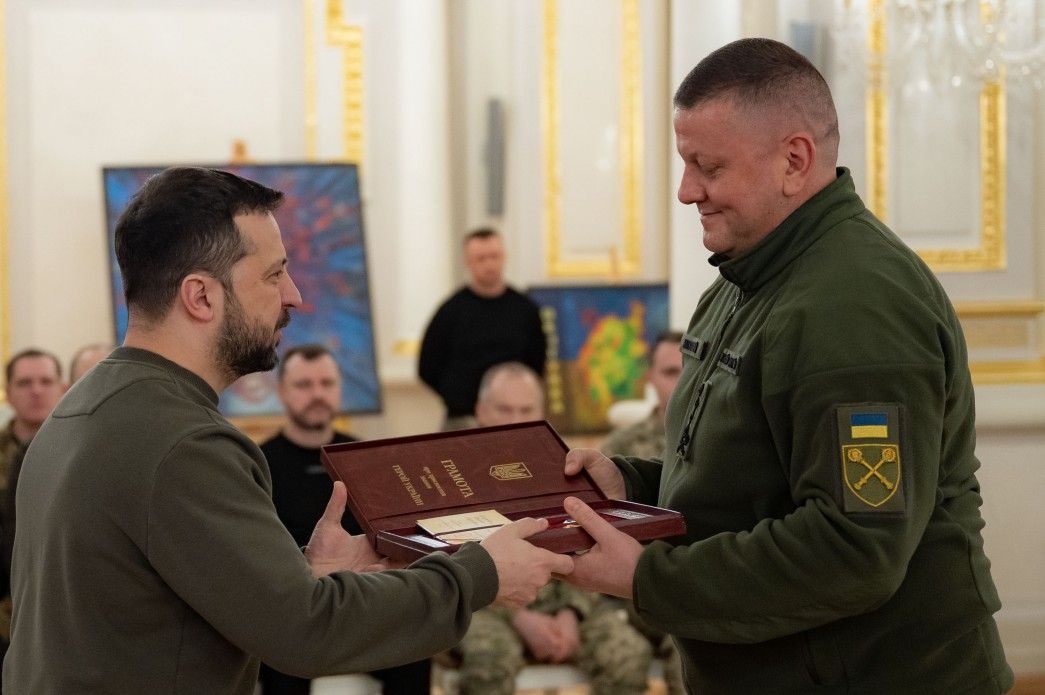 President Zelensky honoring General Valerii Zaluzhnyi for his past service as Commander-in-Chief.
President Zelensky honoring General Valerii Zaluzhnyi for his past service as Commander-in-Chief.
Oleksandr Porkhun, a decorated war hero, has been named Ukraine’s acting veterans affairs minister following Yuliia Laputina’s resignation. A veteran of the conflict with Russian-backed forces and a recipient of Ukraine’s highest honor, Porkhun brings frontline leadership experience to the role, having commanded a battalion in the notable Battle of Donetsk Airport. His appointment comes amid President Zelensky’s call for “fresh energy” and a focus on enhancing state policies for veterans. Laputina faced criticism for her handling of veteran affairs, including communication issues and delays in key programs.
Oleksii Danilov, Secretary of Ukraine’s National Security and Defense Council, refuted Russian allegations that Ukrainian POWs were aboard the Russian Il-76 aircraft that crashed in Belgorod Oblast on January 24. In an interview with Babel, Danilov categorically denied the presence of Ukrainian prisoners on the plane, challenging Russia’s failure to provide evidence and its lack of response to Ukraine’s request to repatriate the bodies. He suggested that Russia would have produced footage for propaganda if POWs had indeed been on board. Contrary to Russia’s narrative, anonymous U.S. officials indicated that a U.S.-made Patriot missile system likely downed the aircraft, which might have been transporting Ukrainian prisoners and was previously used for missile transportation, making it a strategic target. The SBU is conducting a criminal investigation into the incident.
Ukrainian authorities allege that Russian forces have escalated their use of chemical weapons in the conflict, a serious breach of the Chemical Weapons Convention, to which Russia is a party. The General Staff of Ukraine’s military asserts that since the onset of the conflict, there have been 815 attacks utilizing munitions laden with toxic chemicals, with a significant spike of 229 incidents in January 2024. Brigadier General Oleksandr Tarnavskyi highlighted an increase in chemical warfare along the Tavriisk front. Weapons employed reportedly include K-51 grenades and RGR and RGO hand grenades, potentially filled with harmful agents such as CS gas or chloropicrin. While these substances, classified as riot control agents, are non-lethal, their use in warfare is strictly prohibited under the convention ratified by Russia in 1997. A deleted admission by Russia’s 810th Naval Infantry Brigade of using CS gas in combat operations further substantiates these claims.
Ukraine is preparing to present economic reforms to the International Monetary Fund (IMF) to ensure financial stability amidst potential delays in aid from the US Congress, Bloomberg reported. The proposed measures, which Ukrainian officials will discuss with the IMF in Kyiv, include increasing domestic bond sales, tax hikes, and federal spending cuts. These reforms aim to demonstrate Ukraine’s capacity to repay its $15.6 billion loan from the IMF independently of further Western assistance.
Ukraine’s Justice Minister Denys Maliuska engaged with G7 ambassadors to discuss vital reforms in the nation’s judicial system and law enforcement to enhance the business environment and secure international support. This comes amidst scrutiny of the Security Service of Ukraine (SBU) following allegations by Bihus.Info of illegal surveillance against its team. Maliuska, advocating for greater governmental oversight of security services, responded to the investigative outlet’s claims, which included a video purportedly showing journalists using drugs. While the SBU continues its probe into the surveillance, the justice minister has expressed pride in the journalists’ work and criticism of the security services’ actions. These developments underscore the Ukrainian government’s commitment to reform and transparency, particularly in the context of bolstering investor confidence and international relations.
The Security Service of Ukraine (SBU) has indicted Serhiy Handzha, a former SBU official, on charges of orchestrating abductions and torture in the Russian-occupied city of Melitopol in Zaporizhia Oblast. Handzha, who served under former President Viktor Yanukovych, defected to Russia in 2014 and later headed the Russian Federal Security Service in Melitopol after the 2022 Russian invasion. Accused of violently suppressing local resistance, Handzha could face up to 15 years imprisonment under Ukraine’s laws against collaboration. Efforts are underway to ensure Handzha’s accountability for his alleged crimes against Ukraine. He has been an international fugitive since 2015, wanted for treason, and had his state awards revoked by Ukraine’s National Security and Defense Council in February 2021.
The Ukrainian Justice Ministry has initiated legal action to confiscate the assets of Dmitry Kiselyov, a high-profile Russian media figure and staunch supporter of Russia’s actions in Crimea and the Donbas regions since 2014. Following Ukraine’s imposition of personal sanctions on Kiselyov in January 2023, which resulted in the freezing of his properties and assets, the ministry is now targeting confiscation, although details on the specific assets in question were not disclosed. This move is part of an ongoing criminal investigation by Ukraine’s Security Service (SBU) into Kiselyov and another individual, Olga Skabeeva, for activities undermining Ukraine’s territorial integrity since Russia’s full-scale invasion in February 2022. Notably, Kiselyov has past ties to Ukrainian media and is reported to own significant property in Russian-occupied Crimea.
The High Anti-Corruption Court of Ukraine has confirmed the Justice Ministry’s claim to seize the assets of Russian-Greek businessman Ivan Savvidi and his wife Kiriyaki, as reported by the Anti-Corruption Action Center. The ruling targets Savvidi’s interests in Ukraine, including the entirety of shares in PJSC Pentopak, a leading packaging producer for meat products, and its subsidiary Atlantis-Pak Ukraine. The decision follows a listing by the StateWatch think tank, which identified Savvidi as one of the oligarchs aiding Russia’s military-industrial complex. Savvidi, a former member of Russia’s United Russia party and an endorser of Crimea’s annexation, has significant business holdings in Greece, including a port and the PAOK football club. The court’s move reflects Ukraine’s ongoing efforts to target economic actors supporting Russian aggression.
The Ukrainian sugar industry faces a potential crisis due to possible EU export restrictions, warns Nazar Mykhailovyn, acting head of Ukraine’s National Association of Sugar Producers. The European Commission’s proposal to cap sugar exports at 2022 and 2023 levels, despite suspending import duties on other Ukrainian goods until June 2025, could lead to overproduction and factory shutdowns. With a production of 1.8 million metric tons and domestic demand at 900,000 metric tons, the limitations threaten one of Ukraine’s record export seasons. Mykhailovyn highlighted that EU food processing companies favor Ukrainian sugar for its quality, compliance with EU standards, and competitive pricing.
Ukraine Mobilization and Defense Industrial Base
Ukrainian Prime Minister Denys Shmyhal announced the establishment of an Industrial and Defense Committee, a significant move aimed at consolidating the efforts of various government sectors towards national defense. This new committee will synchronize the activities of the Ministry of Strategic Industries, Ministry of Defense, Ministry of Economy, Ministry of Innovation, Ministry of Internal Affairs, and the Ukrainian Security Service (SBU). The initiative is designed to expand Ukraine’s defense industrial base, create a supportive ecosystem for defense manufacturers, and enhance collaboration between Ukrainian and international defense entities, signifying a strategic push to bolster Ukraine’s defense capabilities amidst ongoing conflicts.
Ukraine’s Allies
Ukraine’s Ambassador to the U.S., Oksana Markarova, has highlighted a “critical shortage” of military equipment, including missiles, urging American lawmakers to approve a substantial $60 billion aid package for Ukraine. In a Bloomberg interview, Markarova emphasized the urgent need for support, noting Ukraine’s dire situation regarding equipment and interceptors. Defense Minister Rustem Umerov echoed these concerns, pointing out Russia’s superior artillery capabilities. Despite these challenges, there’s optimism for a $95 billion funding package for Ukraine and Israel, following the U.S. Senate’s move to consider a foreign aid package that bypasses border policy reforms. This development signals bipartisan support, though its final approval, especially in the Republican-controlled House, remains uncertain. Markarova stressed the importance of continued U.S. support for Ukraine’s defense efforts.
A delegation from Estonia, Iceland, Sweden, Denmark, Latvia, and Lithuania visited the U.S. Congress on February 8, advocating for sustained American support for Ukraine amidst the ongoing conflict. The visiting lawmakers expressed concern over a growing sense of isolationism in the U.S. and a lack of urgency regarding the war in Ukraine, contrasting sharply with the unity and commitment seen in Europe. The delegation’s visit underscores the critical juncture at which U.S. involvement in supporting Ukraine stands, with European allies emphasizing the inability to compensate fully should American aid wane.
German Chancellor Olaf Scholz’s visit to Washington, D.C., on February 8, focusing on discussions with U.S. Congress members and a forthcoming meeting with President Joe Biden, highlights the urgent need for continued aid to Ukraine. Scholz’s engagement with bipartisan senators underscores Germany’s call for unwavering support for Ukraine against Russian aggression. His emphasis on the necessity of increased commitments from both Europe and the U.S. reflects a pivotal moment in the international response to the Ukraine crisis, advocating for a collective effort to bolster Ukraine’s defense capabilities.
A delegation from the U.S. House of Representatives, led by House Intelligence Chair Mike Turner, arrived in Ukraine to reaffirm America’s support amidst ongoing military aid discussions in Congress. The bipartisan group, including Representatives French Hill, Jason Crow, and Abigail Spanberger, met with Ukrainian officials, including President Volodymyr Zelensky, to express the U.S.’s commitment to assisting Ukraine against Russian aggression. The delegation’s presence underscores significant bipartisan support in the U.S. for Ukraine, emphasizing the urgent need for continued assistance as legislative processes unfold.
The U.S. Office of Foreign Assets Control (OFAC) has imposed new sanctions on four companies and one cargo ship for breaching the $60-per-barrel price cap on Russian oil trade, marking OFAC’s second enforcement action in 2024. Targeted sanctions were placed on entities based in the United Arab Emirates (UAE) and Liberia, continuing a pattern of actions against those circumventing the cap.
Italy’s lower house of parliament has ratified a one-year extension of military aid to Ukraine, following the Senate’s approval, committing to support through 2024. This decision underscores Italy’s ongoing commitment to Ukraine’s sovereignty and international law, aligning with NATO and EU allies’ stance for a just peace. The extension, supported by 218 out of 400 representatives, highlights Italy’s role in the international effort to aid Ukraine amidst U.S. funding delays due to political deadlock. With a total commitment of 1.3 billion euros ($1.4 billion) to Ukraine, including nearly 700 million euros ($754 million) in military assistance, Italy continues to be a pivotal contributor to Ukraine’s defense against aggression.
Finland committed to its 22nd tranche of defense support, providing Ukraine with a substantial €190 million ($205 million) package of defense materiel. Additionally, Finland has expanded its support by joining the artillery and demining coalitions within the Ukraine Defense Contact Group.
The Union of Armenians of Ukraine and the Armenian Embassy facilitated the delivery of 10 tons of medical equipment to one of Ukraine’s principal military hospitals, marking a significant contribution from Armenia amidst the ongoing conflict. Despite Armenia’s traditional alliance with Russia and its cautious stance on the Russia-Ukraine war, the dynamics shifted following Azerbaijan’s incursion into Nagorno-Karabakh and the perceived inadequacy of Russian “peacekeepers” in protecting the region. This delivery follows Armenia’s initial humanitarian aid sent to Ukraine in September 2023, amid deteriorating ties with Russia post-Nagorno-Karabakh conflict. Armenian Prime Minister Nikol Pashinyan has notably acknowledged a reevaluation of Armenia’s defense strategy away from reliance on Russia. Armenia’s ambassador to Ukraine, Vladimir Karapetyan, highlighted the involvement of up to 12,000 ethnic Armenians, including citizens, in the Ukrainian military efforts, with over 300 receiving medals for their valor. This gesture underscores Armenia’s support for Ukraine during a critical period of warfare.
The Norwegian government has proposed an additional procurement of NASAMS rocket launchers, totaling an investment of 3.45 billion Norwegian kroner (about $327 million).
Life in Occupied Regions
In preparation for the forthcoming Russian presidential elections, occupation authorities in Ukrainian territories controlled by Russia are reportedly fostering an illusion of widespread support for President Vladimir Putin. According to claims by the election commission in occupied Kherson Oblast, over 468,000 individuals have registered as Russian voters in the region. However, reports from ISW and Ukrainian sources suggest that such registration often involves intimidation and coercion. Additionally, the commission detailed the “InformUIK” Program’s efforts to train volunteers, possibly local collaborators or Russian officials, in election preparation tactics, including door-to-door canvassing, aiming to influence the electoral outcome in these occupied areas.
Ukraine’s National Resistance Center has exposed Russia’s ongoing efforts to militarize Ukrainian teenagers in occupied Zaporizhia Oblast through the establishment of military camps, targeting the youth with weapons and engineering training under the guise of patriotic education. These actions include the planned conversion of the “Iskra” children’s camp into a “Warrior” military-sports training center. Additionally, Russia’s strategy extends to the education system in Melitopol, where drone collection initiatives have been reported in schools, and plans to teach primary students drone assembly during labor lessons. These repressive measures against Ukrainians resisting the Russification of their education underscore the broader campaign of identity suppression and forced assimilation, amidst threats of severe repercussions for non-compliance.
Russia News
Ukrainian forces have reportedly executed a successful drone attack on two oil refineries in Russia’s Krasnodar Krai, according to the Ukrainian news outlet Suspilne, which cites sources from the country’s security service. The strikes targeted the Ilsky and Afipsky refineries. Although the Russian Ministry of Defense has asserted that air defenses intercepted the drones, evidence of a fire at the Ilsky refinery suggests otherwise.
Russian Mobilization and Defense Industrial Base
An investigative report by The Insider and IrpiMedia has revealed that Italian arms giant Beretta, through its subsidiary and Russian arms dealer Mikhail Khubutia’s companies, continues to export small arms to Russia, circumventing EU sanctions imposed in 2014. Beretta Industrie SPA and Khubutia oversee Russian Eagle LLC, Beretta’s official distributor in Russia. Notably, nearly half of all arms supplied to Russia against sanctions are attributed to Beretta-owned entities. Despite the EU’s prohibition on rifled weapon supplies to Russia, sniper rifles, pistols, and ammunition have been funneled through the Customs Union of the Eurasian Economic Union. The investigation highlighted that over 835,000 rounds of ammunition and 5,900 small arms from Beretta and its associated brands have been imported into Russia since the onset of the full-scale invasion of Ukraine in February 2022. Additionally, CD Europe SRL, another Italian manufacturer, has been exporting rifles to Russia, underscoring the ongoing breach of international sanctions by European arms firms.
Ukraine’s National Agency on Corruption Prevention (NACP) has designated Allied Mineral Products, LLC, a U.S.-based refractory manufacturing company, as an “international sponsor of war” due to its ongoing operations in Russia. This list serves as a reputational measure, aiming to pressure companies to cease their Russian engagements, thereby cutting down Moscow’s financial resources for its war efforts. Allied Mineral Products, known for producing heat-resistant materials potentially applicable in military equipment manufacture, operates a facility in Tatarstan, Russia, a region linked to the production of Shahed-type drones used against Ukrainian targets. The NACP highlights that the company has continued importing materials into Russia post-February 2022 that could support drone production, including ceramics.
Russian Narratives for Propaganda or What Tucker Carlson Will Be Saying Tomorrow
In a recent interview with American media host Tucker Carlson, Russian President Vladimir Putin offered no new insights, instead reiterating familiar Kremlin positions on the invasion of Ukraine, according to the Russian online community and milbloggers. This has been characterized as an effort to influence Western media rather than address Russian citizens. Kremlin sources and Russian opposition outlet Meduza indicate that the intent was to sway American public opinion and demonstrate Putin’s influence on global discourse. Kremlin Spokesperson Dmitry Peskov confirmed the interview’s popularity in the West, while Russian officials claimed its high viewership highlights an increasing global interest in Putin’s narrative.
Dmitry Medvedev, Deputy Chairperson of the Russian Security Council, has emphasized the stark message from President Vladimir Putin’s recent interview, where Putin declared to the Western audience his view that Ukraine has no past, present, or future as an independent state. Medvedev’s interpretation of the interview underscores Russia’s unwavering stance on Ukraine, indicating that negotiations, if any, would only be considered on terms aligned with these maximalist objectives.
The Russian Foreign Ministry has escalated its rhetoric against Finland, labeling the country’s foreign policy as “unfriendly” and “anti-Russian.” Russian Ambassador to Finland, Pavel Kuznetsov, criticized Finland’s foreign policy approach, alleging it is entirely oppositional to Russia and filled with anti-Russian sentiment. Kuznetsov suggested that Finland’s foreign policy is influenced by external forces, notably the United States, especially after Finland joined NATO in 2023. He warned that Russia would “firmly and decisively respond” to Finland’s actions, accusing Finland of fostering an “anti-Russian psychosis” that adversely affects the nearly 100,000 Russian compatriots living in Finland.
A Kremlin-aligned military blogger has echoed official narratives, arguing that Moldova’s attempts to distance itself from Russia and reintegrate Transnistria are detrimental to its national interests. The blogger highlighted an incident where a Molotov cocktail was thrown at the NATO Information Center in Chisinau, suggesting it as evidence of growing opposition to President Maia Sandu’s pro-EU and NATO stance. Further accusations were made against Sandu for allegedly exacerbating tensions by aiming to incorporate Transnistria into Moldova’s legal framework, implementing new taxes on Transnistrian businesses, and not recognizing Transnistrian passports. The post describes Moldova’s social climate as worsening, framing these developments as part of broader Russian efforts to destabilize Moldova and lay the groundwork for potential aggressive actions.
Source Materials
Institute for the Study of War – understandingwar.org
The Kyiv Post – kyivpost.com
The Kyiv Independent – kyivindependent.com
Militaryland.net (maps)
